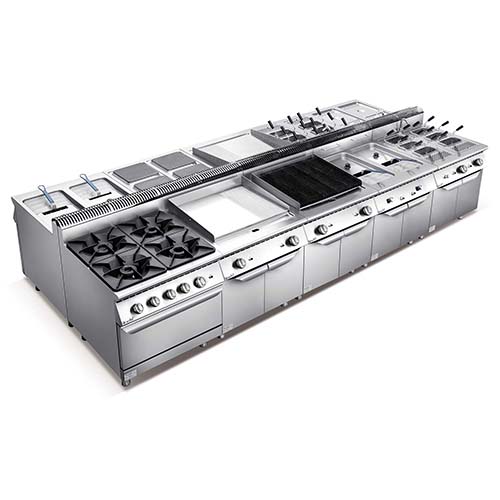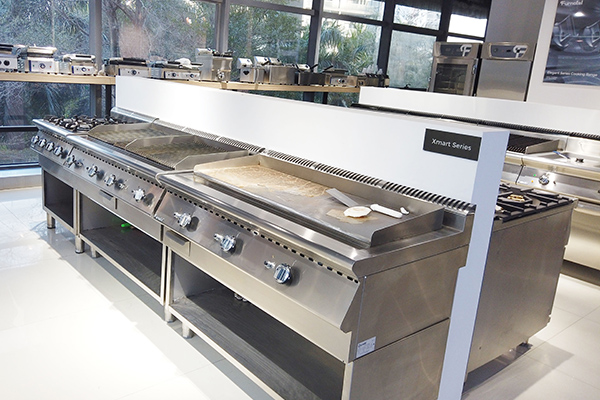SHINELONG-A leading supplier of turn-key solutions in the hospitality and catering since 2008.
Hospitality Kitchen Equipment: Things You May Want to Know
When manufacturing hospitality kitchen equipment, Guangzhou Shinelong Kitchen Equipment Co., Ltd. continuously enhances quality through monitoring and continuous improvements. We carry out a 24-hour shift system to monitor the operation of the whole factory to ensure that the high quality product can be made. Also, we constantly invest in machine updates to improve the efficiency of production.
Our products have been sold far to America, European and other parts of the world and have earned positive feedback from customers. With the increasing popularity among the customers and in the market, the brand awareness of our Shinelong is enhanced accordingly. More and more customers are seeing our brand as the representative of high quality. We will do more R&D efforts to develop more such high-quality products to meet a wider market demand.
Customers have access to professional customer-service staffs who can speak different languages. We have strict languages and working skills training for our staffs who are responsible for customer-service, and we often organize many activities to improve their specialized knowledge and language level. Thus, they can eventually improve our service quality at SHIENLONG.
What Defines a Commercial Food Processor?
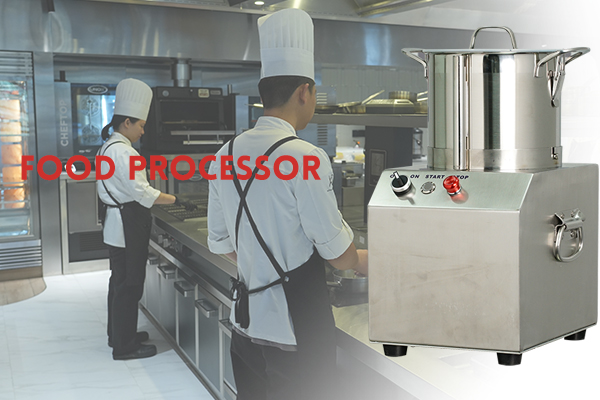
As the all-star multitasker designed for high-volume tasks, a commercial food processor stands out with its powerful motor (typically over 800W), enabling it to operate at full speed for 4 - 8 hours continuously. This contrasts with home models, which can't match its endurance. The 8 - 20-liter work bowl of a commercial food processor handles three to five times the capacity of a home unit in one go, making it ideal for large-scale food preparation tasks that are common in commercial settings.
Constructed from 304 stainless steel or food-grade engineering plastic, commercial food processors are built to last. Their materials not only ensure durability but also meet HACCP standards for hygiene and safety. The heavy-duty design provides industrial-strength protection, which is essential in high-volume kitchens where efficiency and reliability are paramount.
One of the most valuable aspects of a commercial food processor is its modular design, which allows for quick changes among over 20 attachments. With attachments ranging from vegetable slicing discs and dough hooks to emulsifying blades, it offers the versatility needed to handle a wide array of food preparation tasks. This adaptability makes it an essential tool for various food service establishments, including hotels, central kitchens, and fast-food chains. These businesses can achieve standardized, batch-oriented production with ease, ensuring consistency and quality across different recipes and menu items.
7 Clear Advantages for Commercial Kitchen Operations
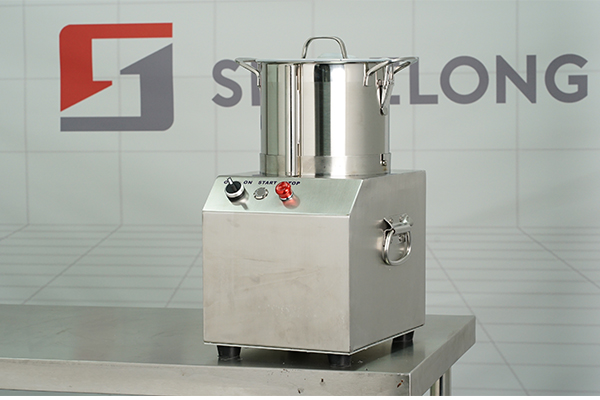
1. Industrial-Grade Efficiency
Shinelong food processing equipment exemplifies how high-duty processors revolutionize prep work. Its 1,200 RPM blade system shreds 15 lbs of cabbage in 90 seconds—a task requiring 25 minutes manually. Continuous feed chutes let staff add ingredients mid-operation, slashing downtime during rush hours. For bakeries, this means whipping 10 L of meringue in one batch while simultaneously kneading dough.
2. Precision Engineering for Consistency
Michelin-starred kitchens rely on devices like our vegetable cutter for millimeter-perfect cuts. Adjustable blades (0.2-8mm thickness) ensure carrot coins in a chain restaurant measure identically across 500 locations. Digital timers sync with blade speeds, guaranteeing uniform texture whether processing tender herbs or frozen meat blocks.
3. Cost-Effective Space Optimization
A single commercial kitchen equipment unit replaces six appliances: mandoline slicers, grinders, mixers, and more. The shinelong food processing equipment demonstrates this versatility—its emulsifying disc creates silken hollandaise while the grating kit produces 40 lbs of cheese per hour. This consolidation reduces equipment costs by 60% and storage needs by 75%, as documented in NRA's 2023 kitchen space utilization study.
4. Enhanced Food Safety Protocols
Commercial models integrate failsafe mechanisms absent in consumer-grade devices. For example, Shinelong's meat slicer features triple-lock safety interlocks that halt operation if the meat is misaligned, while antimicrobial blade coatings inhibit bacterial growth. NSF-certified models reduce cross-contamination risks through seamless, crevice-free designs.
5. Labor Cost Reduction
According to NAFEM's analysis, a commercial food processor handling 200 lbs of daily prep cuts labor hours by 4.5 per shift. Actually, our commercial appliance achieves this through automated batch processing—its 20L bowl preps salad bases for 300 covers without manual intervention, allowing staff to focus on plating and quality control.
6. Energy Efficiency at Scale
High-duty motors in commercial-grade food processors deliver superior energy efficiency compared to multiple smaller appliances working in tandem. Lab tests demonstrate that a 1,500W industrial model consumes only 0.4 kWh to process 100 pounds of vegetables, while three conventional 500W household units require 1.8 kWh for the same task. This stark difference in energy consumption translates to annual savings exceeding $2,500 for an average restaurant, highlighting how commercial kitchen equipment optimizes power usage through robust engineering and streamlined workflows. By consolidating tasks into a single high-performance system, kitchens reduce both electricity waste and operational costs without compromising output quality.
7. Adaptability Across Cuisines
From sushi bars to steakhouses, these processors solve niche challenges. Some processing machine creates paper-thin beef slices for shabu-shabu using their -4°C chilled blade system, while pulsing salsas without crushing delicate herbs. Food trucks particularly benefit from a compact food processor, which processes 8 lbs of taco fillings per minute using 30% less counter space.
Conclusion
Investing in a professional food processor isn't just about speed—it's about building a resilient commercial kitchen infrastructure. As ingredient costs and labor shortages intensify, these machines provide the precision, scalability, and compliance modern food businesses demand. Whether perfecting a signature sauce or standardizing global menus, they're the invisible force driving profitability in today's competitive culinary landscape.
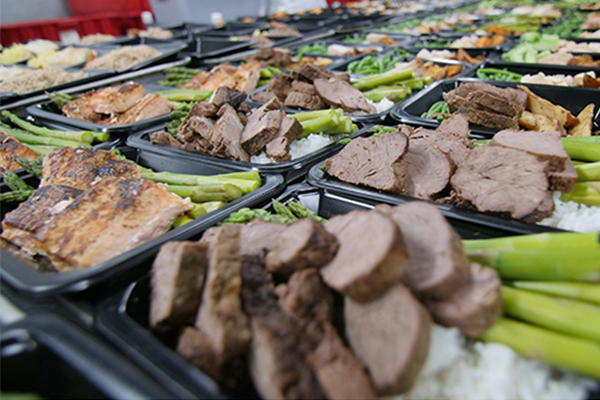
- What is a food processor?A food processor is an electric kitchen appliance with interchangeable blades revolving inside a container to chop, slice, shred, mince, purée, or otherwise process food quickly.
- What is the use of a commercial food processor?A commercial food processor streamlines high‑volume kitchen tasks—such as slicing, dicing, shredding, pureeing, and mixing—to save labor and ensure uniform results in hotels, central kitchens, and fast‑food chains.
- What are the advantages of using a food processor?Food processors save time by automating repetitive prep tasks, delivering consistent texture across batches, and handling a wide range of functions—from shredding and slicing to kneading—thanks to versatile attachments.
- Why is a food processor better than a blender in a commercial kitchen?Unlike blenders geared toward liquids, food processors excel with solid ingredients—chopping, slicing, and kneading dough, making them more versatile for batch prep and thicker consistencies.
- Are you manufacturer?Yes,we are half manufacturer half trading company. Manufacturing Furnotel brand equipment, trading for all kinds of kitchen equipment,especially turn-key solution.
- Is it worth having a food processor?For cooks who frequently prepare sauces, nut butters, doughs, or large quantities of ingredients, a food processor is a worthwhile investment, offering durable, multifaceted performance that outpaces manual prep.
As global energy costs rise 18% year-over-year (NRA 2024), commercial kitchens demand innovative cooking equipment that balances operational efficiency with sustainability. Leading this shift are three groundbreaking systems: Shinelong's heavy-duty stainless steel range clusters, high-output MAX Series cooking range, and space-optimized X Series countertop units. These solutions address critical 2025 challenges—from reducing carbon footprints to enabling commercial kitchen scalability—through advanced thermal engineering and smart connectivity.
Industrial-Grade Durability Meets Precision Control
In the stress test, Shinelong's 900 Series 4-burner gas range demonstrated 0.02mm thermal deformation after 18 hours of continuous operation, validating its status as benchmark commercial restaurant equipment. The secret lies in three innovations:
Multi-Fuel Adaptability: Proprietary unique technology enables instant switching between natural gas, LPG, and biofuels.
Gradient Temperature Control: ±5°C precision via electronic ignition systems, ideal for delicate French sauces or high-heat wok cooking.
NFPA 96 - Compliant Safety: Quick-swap flame monitoring modules reduce maintenance downtime by 40%.
The modular design allows chefs to reconfigure stations seasonally—swapping 700 Series flat griddles for grooved models transforms a breakfast line into a teppanyaki station without infrastructure changes.
High-Density Thermal Engineering for Premium Service
When Michelin-starred The Attic integrated Shinelong's Max Series 6 - Burner gas range, their cooking workflow became more efficient. This improvement is due to several key features:
High power burner: Max Series's power is 20% over than the normal European type. You will have an experience of fast cooking you have never had before, which would make your business more convenient.
Easy maintenance: simple structure makes the maintenance and cleaning simple. You will have fewer after-sales worries and fewer troubles while using Shinelong's Max series.
Multi-combination: We not only have different sizes of each M-Series to fit different kinds of society catering, but also you can combine the M-Series to make full use of your kitchen space.
Space - Optimized Systems for Next-Gen Concepts
At Shenzhen's Lapiana, X-Series countertop equipment enabled 800 daily covers in a 35 sq ft kitchen through:
Vertical Stacking: 650mm - deep electric griddles and fryers support back - to - back installation.
Adaptive Energy Modes: Electric ranges with 0 - 300°C infinite control reduce energy waste by 22% versus conventional models.
NSF - Certified Hygiene: Fully welded stainless housings withstand 1,500PSI spray-downs.
For commissary kitchens, X-Series'plug-and-play design slashes startup costs—Guangzhou's ChefHub reported an 11-month ROI using modular electric cooking range combos versus 18 months for traditional setups.
Building Sustainable Kitchen Ecosystems
True innovative cooking systems transcend individual appliances. Shinelong's integrated approach delivers:
Waste Heat Recovery: 68% of range exhaust heat repurposed for dishwashing preheating.
Predictive Maintenance: Bearing failure alerts 72 hours before critical thresholds.
Closed-Loop Material Flow: 92% stainless components recyclable via take-back programs.
![shinelongs cooking series]()
Why We Have Delivered Over 3000 Kitchen Projects
From cruise ship galleys to star-rated hotels, Shinelong's commercial cooking equipment drives measurable outcomes:
18% Lower TCO: 8-year structural warranties with performance guarantees.
Future-Proof Compliance: Meets draft EU Ecodesign 2027 standards 24 months early.
Scalable Solutions: From single-store electric griddle packages to comprehensive commercial kitchen solutions.
- F.A.Q.Frequently Ask Questions
- What cooking equipment do you need for a commercial kitchen?Essential commercial cooking equipment includes:
Stainless steel range (gas/electric)
Cooktops (griddles, fryers, charbroilers),
Ovens (convection, combi, or deck),
Ventilation systems (hoods and exhausts),
Refrigeration units,
Food prep stations (cutting boards, sinks) - What is the difference between a gas and an electric oven?Gas ovens: Use open flames for heating; excel in moisture retention, ideal for roasting/baking.
Electric ovens: Use heating elements; provide precise, dry heat for consistent baking/pastries.
Key factors: Gas offers faster temperature adjustments; electric ensures uniform heat distribution. - Do you prefer an electric cooktop over induction?Choose based on needs:
Electric cooktops: Lower cost, compatible with all cookware, but less energy-efficient.
Induction cooktops: 30% faster heating, precise control (±1°C), but require magnetic pans.
Professional recommendation: Induction for precision cooking; electric for budget flexibility. - Do you need a range hood for an induction cooktop?Yes. While induction produces less smoke, range hoods remain critical for:
Removing grease aerosols eliminating cooking odors, maintaining air quality per health codes. Opt for hoods with ≥400 CFM airflow for compliance. - Are you manufacturer?Yes, we are half manufacturer, half trading company. Manufacturing Furnotel brand equipment, trading for all kinds of kitchen equipment, especially turn-key solutions.
- Do you have installation service?Yes, we have engineering team for installation instructions, but it will be extra charged.
As the cornerstone of any successful commercial kitchen operation, the dynamic nature of equipment maintenance cannot be overstated. Here's how to ensure your kitchen equipment operates effectively post-installation:
Equipment Placement: Position equipment in a manner that streamlines workflow and skews towards efficiency. The layout should be such that there is minimal movement required between workstations and high-performance equipment is easily accessible.
Run Tests: Once the installation is done, run initial tests on your equipment to ensure they are working as expected. Testing allows you to assess the performance and tweak any settings for optimal functionality.
Staff Training: Conduct comprehensive training for kitchen staff on how to use each piece of equipment efficiently and safely. Proper training reduces the chances of mishandling or misuse of the devices, which can lead to early equipment malfunction or breakdown.
Schedule Regular Maintenance: Regular maintenance checks should be part of your standard operating procedure. Preventive maintenance can help detect potential issues early and prevent costly breakdowns. This should include tasks such as cleaning, lubrication, calibration, etc.
Use Manufacturer-recommended Spare Parts: Always use genuine, manufacturer-recommended parts for any replacements. Inferior or cheap parts can compromise the functionality and durability of your devices.
Adhering to Usage Instructions: Ensure that all staff adhere to the manufacturer's usage instructions. Overuse or misuse can significantly reduce equipment lifespan, leading to frequent breakdowns.
Keep Records: Keep a detailed record of each equipment's maintenance schedules, repairs, and part replacements. Records can help you manage your equipment more effectively and plan your budgets for future maintenance or replacements.
Last and certainly not least, the cleanliness and hygiene of kitchen equipment are important factors in ensuring the operational efficiency of the equipment. Equipment in the process of use, easily accumulates oil, dirt, residue, etc., if not timely cleaned up, which will lead to a decline in the effectiveness of the equipment heat exchange, and even affect the normal work of the equipment. Therefore, it is necessary to regularly clean the equipment, using professional cleaning agents and cleaning tools, to carry out careful and thorough cleaning of the equipment. In addition, handling ingredients should also be kept hygienic, and no ingredients or stains should be left inside the equipment, so as not to corrode the equipment or cause cross-contamination.
In conclusion, ensuring the effective operation of your kitchen equipment post-installation is not an uphill task. It requires a proactive approach and adherence to best practices to maintain the functionality and longevity of your devices. With proper care, your kitchen can function as a well-oiled machine making any service provision seamless and, in turn, contributing to the growth of your restaurant's reputation and customer satisfaction.
About SHINELONG
Stainless steel sinks first appeared in Europe and the United States, and Chinese stainless steel sinks first appeared in Taiwan. In the early 1990s, Taiwanese businessmen introduced stainless steel sinks when they invested in the mainland to build factories. In the early days, there were Mantangchun sinks, and in the later days, there were Molin sinks. How to identify the quality of good stainless steel sinks for environmentally friendly kitchen equipment? 1. The thickness of the sink steel plate: high-quality sinks use imported 304 stainless steel plates with a thickness of 1mm, while ordinary low-end sinks use 0.5mm-0.7mm. The method of identification can be distinguished from the weight and whether the surface is flat. 2. Anti-noise treatment: The bottom of a high-quality sink is sprayed or glued with rubber sheets and does not fall off, which can reduce the noise caused by the impact of the faucet water on the bottom of the basin and play a buffering role. 3. Surface treatment: The surface of a high-quality sink is flat, the luster is soft visually, it is not easy to stick to oil stains, it is easy to clean, and it is wear-resistant. 4. Inner corner treatment: The inner corners of a high-quality sink are close to 90 degrees, the vision inside the sink is larger, and the basin volume is larger. 5. Supporting parts: high-quality water heads require thick walls, smooth processing, no water leakage when the cage is closed, durable and comfortable touch beads. Downpipes are required to be made of environmentally friendly disposable materials, easy to install, odor-proof, heat-resistant, aging-resistant and durable. 6. Sink molding process: One-piece molding technology solves the leakage problem caused by the welding of the basin body, which causes the weld to be unable to withstand the corrosion of various chemical liquids (such as detergents, stainless steel cleaners, etc.). The one-piece molding process is a particularly important process, which has high requirements for the steel plate material. What kind of process is used is an obvious reflection of the quality of the sink.
Author:SHINELONG-Commercial Kitchen Equipment Solutions Suppliers
Introduction
Energy efficiency is a crucial consideration for hotels and hospitality establishments nowadays. In an era where sustainability is given immense importance, businesses are continually seeking innovative solutions to reduce their carbon footprint. One area where energy consumption can be significantly decreased is dishwashing and cleaning equipment. By investing in energy-efficient dishwashers and cleaning equipment, hotels can not only contribute to environmental conservation but also save on operational costs. In this article, we will explore the benefits of energy-efficient dishwashers and cleaning equipment for hotels and how these technologies can make a positive impact on the industry.
The Advantages of Energy-efficient Dishwashers
Energy-efficient dishwashers have emerged as a valuable asset for hotels aiming to enhance their sustainability practices. These technologically advanced machines not only deliver exceptional cleaning results but also offer numerous advantages:
1. Reduced Energy Consumption
Energy-efficient dishwashers are designed to minimize energy consumption without compromising cleaning performance. These machines incorporate advanced features such as heat exchangers, improved insulation, and efficient water circulation systems to optimize energy usage. By using less electricity and hot water, energy-efficient dishwashers can help hotels significantly reduce their energy bills.
2. Enhanced Water Efficiency
Water scarcity is a growing concern worldwide, and hotels are responsible for considerable water consumption due to their large-scale operations. Energy-efficient dishwashers are equipped with water-saving technologies, such as sensors and spray arms, which ensure that the optimal amount of water is used for each dishwashing cycle. By reducing water usage, hotels can conserve this precious resource and contribute to sustainable water management.
3. Time-saving Automation
In a bustling hotel environment, time is of the essence. Energy-efficient dishwashers feature automated processes that streamline dishwashing operations. From pre-wash to drying, these machines can efficiently handle large volumes of dirty dishes, utensils, and glassware. By automating the dishwashing process, hotels can save valuable time and allocate their staff resources more effectively.
4. Reduced Chemical Usage
Traditional dishwashing methods often rely on chemical-intensive cleaning agents to achieve satisfactory results. Energy-efficient dishwashers, on the other hand, utilize advanced cleaning technologies that require fewer chemicals. By minimizing chemical usage, hotels can create a safer environment for both their staff and guests while also reducing their ecological impact.
5. Minimized Breakage and Damage
Energy-efficient dishwashers employ innovative dish rack designs and adjustable wash cycles that contribute to reducing breakage and damage to delicate tableware. By ensuring gentle yet effective cleaning, these machines enable hotels to extend the lifespan of their dishware, thereby reducing replacement costs and waste generation.
Energy-efficient Cleaning Equipment: A Sustainable Solution
Apart from dishwashers, energy-efficient cleaning equipment is revolutionizing the housekeeping operations in hotels. This equipment offers several benefits that contribute to sustainability within the hospitality industry:
1. Smart Vacuum Cleaners
Energy-efficient vacuum cleaners employ cutting-edge technology, such as high-performance motors and optimized air flow systems, to deliver superior cleaning results while consuming less energy. These smart vacuum cleaners also feature robotic functionalities that enable them to navigate and clean spaces autonomously, reducing the need for manual labor. By utilizing energy-efficient vacuum cleaners, hotels can keep their premises clean and save on energy costs simultaneously.
2. Eco-friendly Laundry Machines
Laundry is a crucial aspect of hotel operations, and traditional laundry machines consume substantial amounts of water and energy. Energy-efficient laundry machines, however, utilize advanced technologies such as heat pumps and moisture sensors to optimize washing cycles. These machines are designed to use less water and specific detergents, thus minimizing the environmental impact. By switching to energy-efficient laundry machines, hotels can achieve substantial cost savings and promote sustainable laundry practices.
3. Efficient Floor Scrubbers
Maintaining clean and polished floors is essential in the hospitality industry. Energy-efficient floor scrubbers combine advanced brush systems, variable speed motors, and efficient filtration systems to deliver effective cleaning with reduced energy consumption. These machines operate quietly, minimize water usage, and offer faster drying times, contributing to overall operational efficiency and sustainability.
4. Smart Window Cleaning
Window cleaning in hotels often requires significant manual labor, which can be time-consuming and risky. Energy-efficient window cleaning equipment utilizes advanced technologies like robotic systems and specialized microfiber pads to achieve streak-free and spotless windows. These automated machines are not only energy-efficient but also enhance worker safety by reducing the need for staff to undertake risky activities on heights.
5. Green Cleaning Chemicals
Energy-efficient cleaning is incomplete without considering the chemicals used in the process. Hotels are increasingly embracing green cleaning chemicals that are biodegradable, non-toxic, and environmentally friendly. These chemicals not only deliver effective cleaning results but also minimize the exposure of hotel staff and guests to harsh chemicals. By utilizing green cleaning chemicals in conjunction with energy-efficient cleaning equipment, hotels can achieve a holistic sustainable approach.
Conclusion
In conclusion, energy-efficient dishwashers and cleaning equipment provide hotels with an opportunity to enhance their sustainability practices while improving operational efficiency. These advanced technologies significantly reduce energy and water consumption, promote automation and time savings, minimize chemical usage, and contribute to maintaining clean and polished premises. By incorporating energy-efficient dishwashers and cleaning equipment, hotels can play a vital role in promoting environmental conservation and meeting their sustainability targets. It is imperative for the hospitality industry to embrace these technological advancements and take proactive measures towards responsible and eco-friendly practices.
.Recommand:
Since Shinelong was established in Guangzhou in 2008, we have made great strides in the fields of commercial kitchen planning and kitchen equipment manufacturing.
IF YOU HAVE ANY QUESTION,PLEASE CONTACT US.
WhatsApp: +8618902337180
WeChat: +8618924185248
Telephone: +8618924185248
Fax: +86 20 34709972
Email: info@chinashinelong.com
After-Sales Contact
Telephone: +8618998818517
Email: service@chinashinelong.com
Add: No. 1 Headquarters Center, Tian An Hi-tech Ecological Park, Panyu Avenue, Guangzhou, China.



















